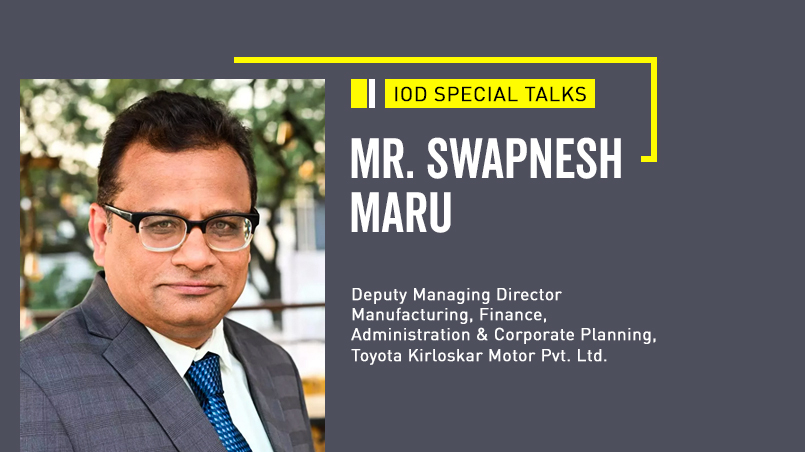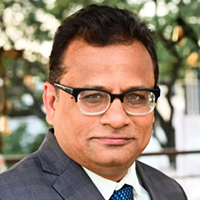 Connect with us
Connect with us

 Aug 05, 2024
Aug 05, 2024
Steering Global Business toward a Greener, Sustainable Tomorrow
My name is Swapnesh Maru. I'm from Toyota Kirloskar Motors, headquartered out of Bangalore. We are a subsidiary of our parent, Tata Motors Corporation, which is based out of Japan but operates in every region of the world.
We are the first generation to feel the impact of climate change, and we are the last who can do something about it. This is something to mull over.
When I was reading the papers, I came across a small clip from the Managing Director of Larsen and Toubro. He laid out a very interesting piece of information. He said that he is facing a labour shortage in two areas: construction labor (around 25,000 people) and, of course, software engineers. Being in Bangalore, I will keep the engineers out and just focus on the construction labourer. One of the reasons he pointed out for this shortage was the heat wave in the country, and that is profound, because a company of that size and scale, for the first time, coming out and declaring that this is one of the reasons shows us that climate change is a problem that is real and that it is at home.
ESG helps you plan your resources effectively. It is a brand differentiator.
The water crisis has reached a point where citizens are almost coming out on the street. This is just a question of time. So the simple point is that climate change is something that is no longer on the backburner. Today, I will speak about ESG and its relevance, but more importantly, what role a board can play in driving ESG, and then, using the example of Toyota, both globally and locally, I will try to take you through actual case studies through which we have implemented our ESG practices. In that sense, I'll try to give you practitioners and how we do this very quickly.
The way ESG has evolved over a period of time, all of them revolve pretty much around the same theme, but the depth with which it has expanded has changed over a period of time. Back in the 1980s and 1990s, it was more about factory side environmental health and safety within sustainability. Then came the concept of CSR, thanks to the regulation push, and now ESG, also with a little bit of regulatory headwind, and now we are in the direction of inclusive reporting as the next step. So, this is one theme that is being mapped out.
Why is ESG important? For a minute, let us keep the environmental and legacy aspects of ESG aside.
Why should companies and boards really look at this as one of their top priorities, apart from making strategies to manufacture and sell products?
We live in a world where you are not sure what risk will hit you from which side. If you understand your ESG contours clearly, the biggest takeaway that you will get is to understand your risk clearly, and once you know your risk, the boards can then tailor strategy. So to me, as a practitioner, this is one of the biggest outcomes of ESG relevance to the board.
Of course, it helps you to plan your resources effectively. It is a brand differentiator and very important the conversations and actions on ESG will help you build relationships with your stakeholders, government, employees, customers, and society at large. These are powerful conversations that can contribute to the chain effect of a bigger brand and better business. So ESG is all about business. It's not just about future action for a future society. It's also a real, tangible outcome.
If you understand your ESG contours clearly, the biggest takeaway that you will get is to understand your risk clearly, and once you know your risk, boards can then tailor strategy.
For example, things like anti-corruption and anti-competitive actions are not really heavy on any board agenda, but these are very relevant as we go forward, so this is one example of how you can move.
Two main factors that the board should consider, apart from designing and tailoring strategies, are to put in matrixes to know that you are moving in the right direction, and, in my opinion, the most important is building the culture and mindset in which ESG is understood and actioned upon in the company. Without this culture-building, a mere policy, rollout, and strong communication will make it without any teeth.
Let me now quickly move to how my parent company, Toyota Motor, Japan, has approached the framework for ESG. This is never a point in time; it's always a journey. So, way back in 1992, we came out with what is called a 'Toyota Earth Charter', which talked about the technological intervention that we could do on a global scale. The voluntary actions that we could take and the community support that we needed to carry them out. Then came one of the most important pieces of policy-making, which is still very strong and prevalent, and I'll extensively touch upon this in my presentation to come.
So let me now take you to the sustainability framework, which is the global roadmap for any company under the Toyota umbrella operating in any region. This has six parameters for themes.
The first one is: how do we ensure, as a target, that the new vehicle that we make has net zero carbon emissions? The second goal is not just the vehicle, but the entire life cycle and the value cycle. How do I commit to net zero? Thirdly, at the plant where I manufacture this car, do I ensure that it is net zero? So these are specific activities and policy frameworks.
We work towards optimizing water usage. We work towards creating a society that is based on recycling, and lastly, we work on the pillars of how we contribute to society, which work in harmony with nature. So we inherit this policy from the parent, and then let me explain how, at the local level, we take this policy challenge by challenge and implement it.
Starting with the first challenge. How do I make the car net zero?
India is a 4 million passenger car market. Even by the most conservative estimates, by 2030 we are going to have at least 5 to 6 million car markets, according to NITI Aayog numbers. Taking a very optimistic case, even if 30% of these 6 million passenger cars (I'm not counting two wheelers or three wheelers; only passenger cars; no commercial vehicles.), 70% are still going to be internal combustion engines (ICE). This is after discounting the 30%, which is an extremely optimistic target. So we are looking at a scenario where we want to make Viksit Bharat. We are looking at challenging some of the biggest goals, but the energy pathway part, which is critical to achieving this goal, is still fossil fuel-based.
Secondly, how do we ensure that the life cycle of the vehicle is net zero?
We have a green purchasing policy where whoever supplies Toyota globally and locally has to follow stringent green standards. Some of the actions we have taken, which come at a huge cost, have moved a lot of suppliers close to our plant, thereby reducing our carbon footprint. Apart from having a clear road map to ensure that, over a period of time, we have targets and milestones, how to move towards net zero.
The third challenge is to ensure a plant becomes net zero.
From the supply side, from the conversion of the energy site, and on the consumption side, we take active intervention and actions to ensure that our actions lead to CO2 emission reductions. We started way back in 2022 with piped gas, then we moved to technologies like heat exchange pumps in a lot of places. We had a solar reflector; now we have our captive investments in energy, and going forward, as regulating mechanisms come into place, we will also look at carbon offsets. Similar inventions are made across the entire value chain.
The fourth challenge is the minimization of water.
The matrices are there for the keys that we use: reduce, reuse, recycle, and recharge. Water is going to be the new oil of the future, and this is something that is very actively involved in our interventions.
Challenge number five is a recycled-based society and system.
Avantika was talking about sugarcane and how they manage to almost get 100% recycling. We are pretty close. We don't have the water component, but 95.33% of our product is still recycled within the plant, and of course we don't stop here; we continue to challenge.
Last but not least, how do we create a society that lives in harmony with nature?
In Japan, we have started a very huge exercise called the 'woven city', when we showcase the confluence of technology, policies, and city planning and how all these can come together to create a habitat that is self sustaining.
Now, let me share some of the initiatives we've implemented at Toyota. One example is our Miyawaki plantation, which has transformed into a mini-forest on our site. We're incredibly proud of this achievement. Initially, this 40-acre area was a dumping yard, but we've converted it into an eco-zone with around 17 distinct themes. We engage students by bringing them out of their classrooms and into this eco-park, where each sector has a specific focus.
For instance, in the solar park, we educate them about the importance of renewable energy. At the rainwater point, we demonstrate aquatic life, biodiversity, and its environmental impact. The energy theme park is another area where we provide hands-on exposure, fostering continued learning and engagement.
ESG is all about business. It’s not just about future action for a future society. It’s also a real, tangible outcome. For example, things like anti-corruption and anticompetitive actions are not really heavy on any board agenda, but these are very relevant as we go forward.
These initiatives are part of our broader CSR efforts, all aligned under our 6Cs framework. It's through these kinds of interventions, driven by top leadership, board policies, and on-the-ground actions that we aim to make a sustainable difference.
While I haven't delved deeply into the social and governance aspects today, they are equally important, and I would be more than happy to showcase them.
I invite all of you to download our sustainability report, which, I assure you, contains numerous metrics, KPIs, and case studies that can help you better understand how we can sustain our actions to ensure a clean and green future for the next generation. Thank you for your patience and attention, and I am happy to answer any questions.

Excerpts from the 'Special Address' delivered by Mr. Swapnesh Maru, Deputy Managing Director, Manufacturing, Finance, Administration & Corporate Planning, Toyota Kirloskar Motor Pvt. th Ltd. in 'Session-III' of the 25 International Conference on Environment Management and Climate Change, held on June 27, 2024 in Hotel The Lalit Ashok, Bengaluru.
Owned by: Institute of Directors, India
Disclaimer: The opinions expressed in the articles/ stories are the personal opinions of the author. IOD/ Editor is not responsible for the accuracy, completeness, suitability, or validity of any information in those articles. The information, facts or opinions expressed in the articles/ speeches do not reflect the views of IOD/ Editor and IOD/ Editor does not assume any responsibility or liability for the same.
About Publisher

Bringing a Silent Revolution through the Boardroom
Institute of Directors (IOD) is an apex national association of Corporate Directors under the India's 'Societies Registration Act XXI of 1860'. Currently it is associated with over 30,000 senior executives from Govt, PSU and Private organizations of India and abroad.
View All BlogsMasterclass for Directors
Categories